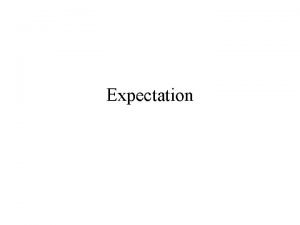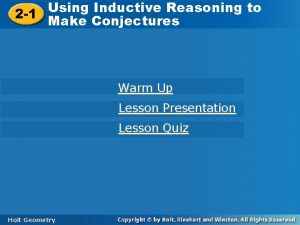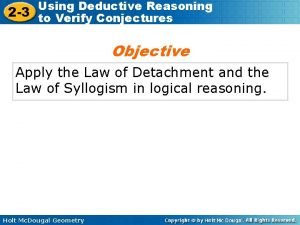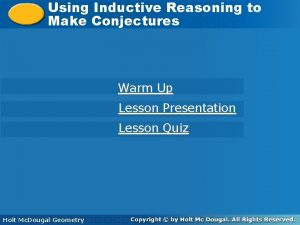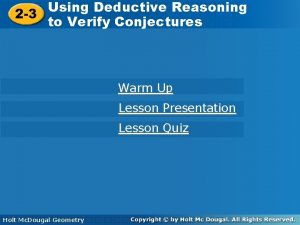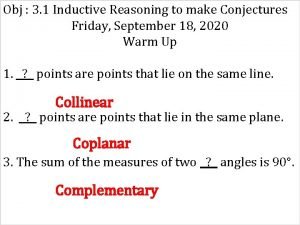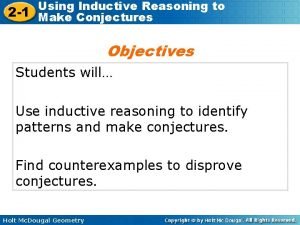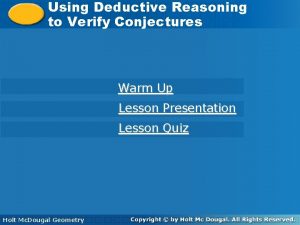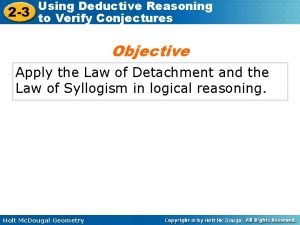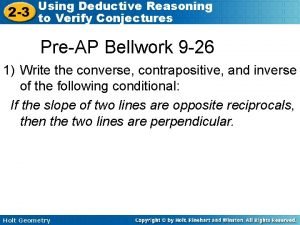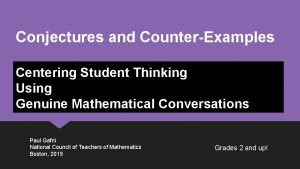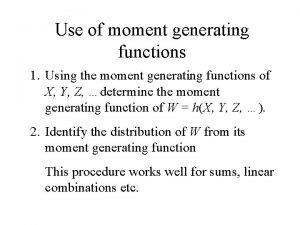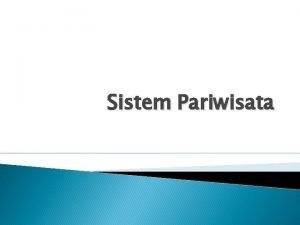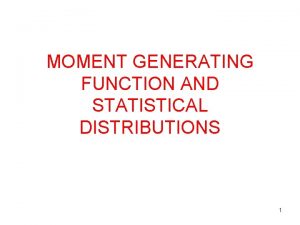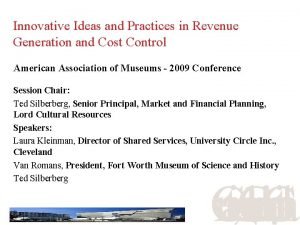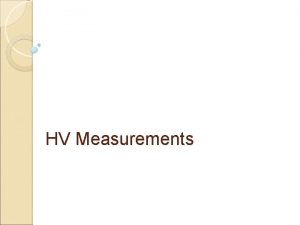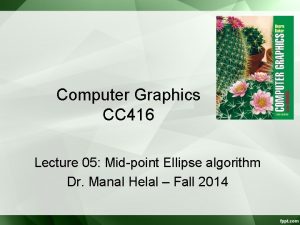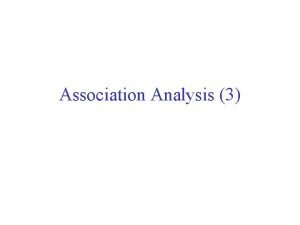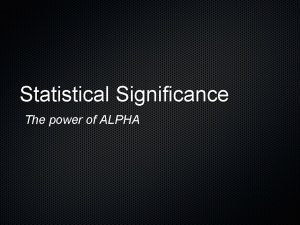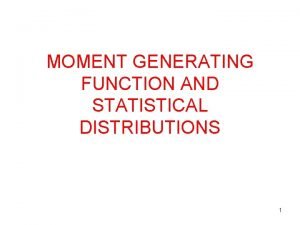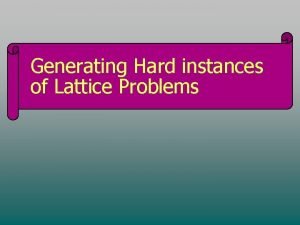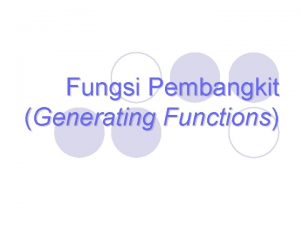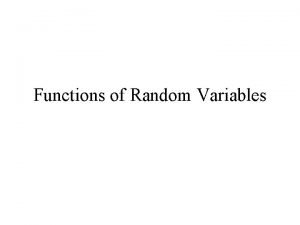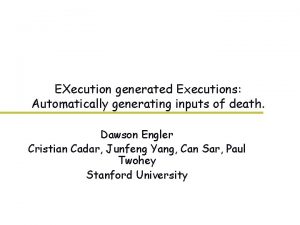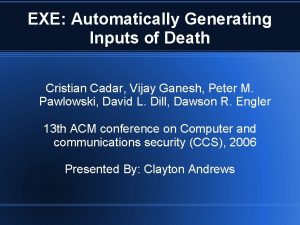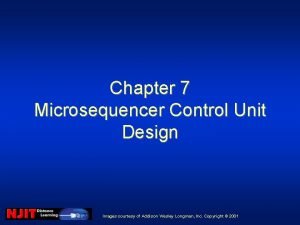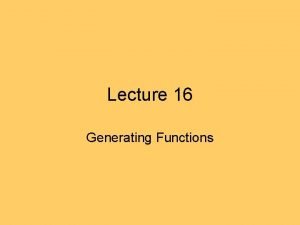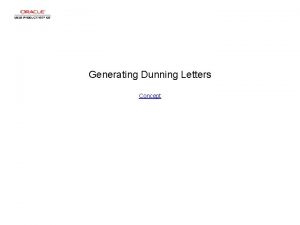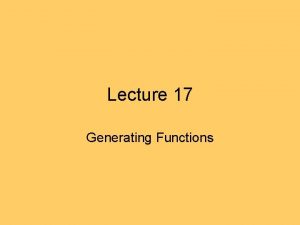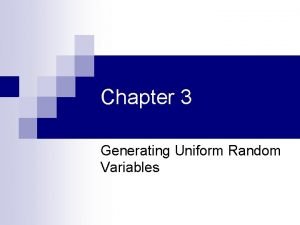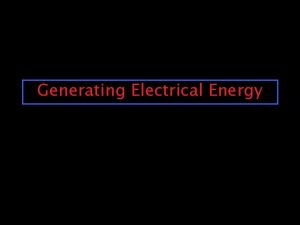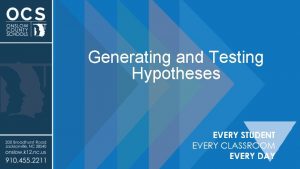Constructing CONJECTURES Constructing CONJECTURES Generating examples Getting literature


![Definition of 132 -pattern Let [n] = {1, 2, …, n}. p = a Definition of 132 -pattern Let [n] = {1, 2, …, n}. p = a](https://slidetodoc.com/presentation_image_h/19a946d66e0ff70b6d74ba15d2edf2e6/image-3.jpg)



![First Problem How many 132 -avoiding permutations of [2 n] are there such that First Problem How many 132 -avoiding permutations of [2 n] are there such that](https://slidetodoc.com/presentation_image_h/19a946d66e0ff70b6d74ba15d2edf2e6/image-7.jpg)






![Proposition. (BP Dela Cruz) For a 132 -avoiding permutation of [2 n] of length Proposition. (BP Dela Cruz) For a 132 -avoiding permutation of [2 n] of length](https://slidetodoc.com/presentation_image_h/19a946d66e0ff70b6d74ba15d2edf2e6/image-14.jpg)
















- Slides: 30

Constructing CONJECTURES

Constructing CONJECTURES Generating examples Getting literature
![Definition of 132 pattern Let n 1 2 n p a Definition of 132 -pattern Let [n] = {1, 2, …, n}. p = a](https://slidetodoc.com/presentation_image_h/19a946d66e0ff70b6d74ba15d2edf2e6/image-3.jpg)
Definition of 132 -pattern Let [n] = {1, 2, …, n}. p = a 1 a 2…an is a permutation of [n]. Consider ai, aj, ak, 1≤i<j<k≤n. High Low a 1 a 2. . . ai. . . Mid aj. . . ak. . . an-1 an If ai < ak < aj, then we say that the ai, aj and ak of p form a 132 -pattern.

Illustration 5 4 3 2 1 1 3 1 2 3 22

Definition of 132 -avoiding permutation If there are no entries in p that form a 132 pattern, then p is said to be 132 -avoiding.

SHUFFLING s(p) p == a 1 a 2 … an-1 an an+1 an+2… a 2 n-1 a 2 n an+1 an+2 a…n+1 an+2 a 2 n-1 … a 2 n-1 a 2 n *animation by BP Dela Cruz
![First Problem How many 132 avoiding permutations of 2 n are there such that First Problem How many 132 -avoiding permutations of [2 n] are there such that](https://slidetodoc.com/presentation_image_h/19a946d66e0ff70b6d74ba15d2edf2e6/image-7.jpg)
First Problem How many 132 -avoiding permutations of [2 n] are there such that the shuffles are also 132 -avoiding?

Counts via Scilab/Fortran 2 n 2 4 6 8 10 No. of tests for No. of p = (2 n)! each p = C(2 n, 3) 1 2! = 2 4! = 24 C(4, 3) = 4 6! = 720 C(6, 3) = 20 8! = 40, 320 C(8, 3) = 56 10! = 3, 628, 800 C(10, 3) = 120

Counts via Scilab/Fortran 2 n 2 4 6 8 10 No. of tests for No. of s(p) = (2 n)! each s(p) = C(2 n, 3) 1 2! = 2 4! = 24 C(4, 3) = 4 6! = 720 C(6, 3) = 20 8! = 40, 320 C(8, 3) = 56 10! = 3, 628, 800 C(10, 3) = 120

Program Outputs Length 4 4. 4. 3. 3. 2. 2. 1. 4. 2. 2. 1. 3. 1. 2. 3. 1. 2. 2. 4. 1. 2. 1. 3. 1. 1. 3. 3. 1. 1. 4. 4. 0. 0. 0. 4. 4. 3. 3. 2. 2. 3. 1. 2. 2. 4. 1. 2. 1. 3. 2. 2. 1. 4. 2. 2. 1. 3. 1. 1. 3. 3. 1. 1. 4. 4. 3. 3. 3.

Program Outputs Length 6

Program Outputs Length 8

CONJECTURE. Consider n≥ 4. p = a 1 a 2…an-1 anan+1…a 2 n and its outshuffle are 132 -avoiding Possible positions of 2 n: a 1, a 2, an+1, an+2, . . . , a 2 n-2, a 2 n-1, a 2 n
![Proposition BP Dela Cruz For a 132 avoiding permutation of 2 n of length Proposition. (BP Dela Cruz) For a 132 -avoiding permutation of [2 n] of length](https://slidetodoc.com/presentation_image_h/19a946d66e0ff70b6d74ba15d2edf2e6/image-14.jpg)
Proposition. (BP Dela Cruz) For a 132 -avoiding permutation of [2 n] of length n≥ 4 with a 132 avoiding shuffle, ak 2 n when 3 ≤ k ≤ n-1.

Summary of Counts Position of 2 n a 1 a 2 an an+1 an+k, 2≤k ≤n-2 a 2 n-1 a 2 n Counts 2 n 2 -4 n+6 1 n-1 2 k(n-k) 2 n-2

MAJOR RESULT Proposition. (BP Dela Cruz) For n≥ 3, number of 132 -avoiding permutations with 132 avoiding (out-)shuffle of [2 n]:

Related literature and conjectures • A 2 -connected graph is hamiltonian if it is K 1, 3 P 5 -free or K 1, 3 P 6 -free (Broersma, Veldman, 1990). • A 2 -connected, K 1, 3 P 5 -free graph is pancyclic if its order (Faudree, et. al, 1995). • A 3 -connected graph is hamiltonianconnected if it is K 1, 3 P 5 -free or K 1, 3 P 5 -free (Broersma et. al. , 2002).

Related literature and conjectures Conjecture 1. A 2 -connected, K 1, 3 P 5 -free graph is 1 -edge hamiltonian. Conjecture 2. A 2 -connected, K 1, 3 P 5 -free graph is 2 -edge hamiltonian.

Theorem. If G is a 2 -connected K 1, 3 P 4 -free graph, |V(G)|≥ 4, with a minimum vertex cut of k vertices, then G is isomorphic to a (Km U Kn)+Hk where Hk is a K 1, 3 P 4 –free graphs on k vertices of at most 2 components. Moreover, if Hk has 2 components, then Hk is a union of 2 complete graphs.

Related literature and conjectures • A 2 -connected, K 1, 3 Z 2 -free graph of order n≥ 3 is pancyclic except cycles (Gould, Jacobson, 1982). • A 2 -connected graph is hamiltonian if it is K 1, 3 Z 2 -free or K 1, 3 Z 3 -free of order n≥ 10 (Faudree, et. al. , 1995). • A 2 -connected K 1, 3 Z 2 -free of order n≥ 10 is cycle-extendable (Faudree, Gould, 1997). • A 3 -connected graph is hamiltonianconnected if it is K 1, 3 Z 2 -free or K 1, 3 Z 3 -free (Broersma, et. al. , 2002).

Related literature and conjectures Conjecture 3. A 2 -connected, K 1, 3 Z 2 -free graph is 1 -edge hamiltonian. Conjecture 4. A 2 -connected, K 1, 3 Z 2 -free graph is 2 -edge hamiltonian.

Theorem. Every 2 -connected K 1, 3 Z 1 -free graph is 1 -edge hamiltonian except for (K 1 U K 1)+K 2.

Theorem. Every k-connected K 1, 3 Z 1 -free graph, k≥ 2, is k-edge hamiltonian except for (K 1 U K 1)+K 2.

Theorem. Every 2 -connected K 1, 3 Z 2 -free graph is 1 -edge hamiltonian except for six exceptional graphs.

Non-1 -edge hamiltonian 2 -connected K 1, 3 Z 2 -free graphs

OBJECTIVES • Examine the conjectures by extending existing results on hamiltonian properties. • Examine (not established) hamiltonianproperties related to the conjectures. • Add (or relax) the conditions to establish results on 1 -edge hamiltonicity or 2 -edge hamiltonicity. • If possible, come up with generalized results.

Generating examples/ getting literature ORGANIZE (Look for patterns) Understanding conjecture Evaluating conjecture Writing conjecture Testing conjecture

Understanding/evaluating CONJECTURES • READ. • COMPARE. • Generate examples and non-examples. • Be careful of counterexamples. • Identify the suitable conditions.

Writing CONJECTURES Some pointers • Does the conjecture appear to be true or false? • Is it obvious or subtle? • Is it easy or difficult to understand? • Is the conjecture general? • Is it specific enough?

Constructing CONJECTURES
 The secret of getting ahead is getting started
The secret of getting ahead is getting started Let x be a random variable that has a skewed distribution
Let x be a random variable that has a skewed distribution Using deductive reasoning to verify conjectures
Using deductive reasoning to verify conjectures Using deductive reasoning to verify conjectures
Using deductive reasoning to verify conjectures Using inductive reasoning to make conjectures answers
Using inductive reasoning to make conjectures answers 2-3 using deductive reasoning to verify conjectures
2-3 using deductive reasoning to verify conjectures Conjecture
Conjecture Using inductive reasoning to make conjectures
Using inductive reasoning to make conjectures Using deductive reasoning to verify conjectures
Using deductive reasoning to verify conjectures Using deductive reasoning to verify conjectures
Using deductive reasoning to verify conjectures 2-3 using deductive reasoning to verify conjectures
2-3 using deductive reasoning to verify conjectures Gafni
Gafni Moment generating function table
Moment generating function table Standard generating body
Standard generating body Elemen indutri pariwisata adalah…
Elemen indutri pariwisata adalah… Negative binomial distribution mean and variance
Negative binomial distribution mean and variance Innovative ideas for revenue generation
Innovative ideas for revenue generation Generating sentences from a continuous space
Generating sentences from a continuous space Advantage of generating voltmeter is
Advantage of generating voltmeter is Ellipse in computer graphics
Ellipse in computer graphics New entry in entrepreneurship
New entry in entrepreneurship Recognizing opportunities and generating ideas
Recognizing opportunities and generating ideas Acegd
Acegd Generating alpha meaning
Generating alpha meaning Multinomial distribution
Multinomial distribution Generating hard instances of lattice problems
Generating hard instances of lattice problems Contoh soal fungsi pembangkit momen
Contoh soal fungsi pembangkit momen Moment generating function of normal distribution
Moment generating function of normal distribution Exe: automatically generating inputs of death
Exe: automatically generating inputs of death Exe: automatically generating inputs of death
Exe: automatically generating inputs of death Are the different types of generating control signals
Are the different types of generating control signals

